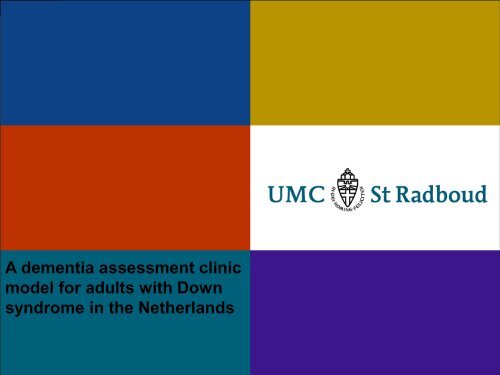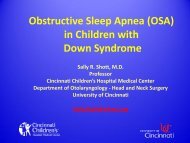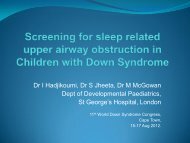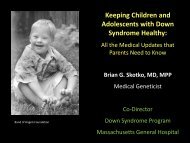A dementia assessment clinic model for adults with Down syndrome ...
A dementia assessment clinic model for adults with Down syndrome ...
A dementia assessment clinic model for adults with Down syndrome ...
You also want an ePaper? Increase the reach of your titles
YUMPU automatically turns print PDFs into web optimized ePapers that Google loves.
A <strong>dementia</strong> <strong>assessment</strong> <strong>clinic</strong><br />
<strong>model</strong> <strong>for</strong> <strong>adults</strong> <strong>with</strong> <strong>Down</strong><br />
<strong>syndrome</strong> in the Netherlands
A <strong>dementia</strong> <strong>assessment</strong> <strong>clinic</strong> <strong>model</strong><br />
<strong>for</strong> <strong>adults</strong> <strong>with</strong> <strong>Down</strong> <strong>syndrome</strong> in the<br />
Netherlands<br />
Antonia Coppus, MD, PhD<br />
Cape-Town 2012
A <strong>dementia</strong> <strong>assessment</strong> <strong>clinic</strong> <strong>model</strong> <strong>for</strong> <strong>adults</strong> <strong>with</strong><br />
<strong>Down</strong> <strong>syndrome</strong> in the Netherlands<br />
I. Introduction<br />
II. Health Watch<br />
III. Results<br />
IV. Conclusion
Introduction: <strong>Down</strong> <strong>syndrome</strong><br />
Characteristics<br />
• <strong>Down</strong> <strong>syndrome</strong> is caused by the triplication of<br />
chromosome 21<br />
• Triplication of chromosome 21 occurs 1/750 live births<br />
• Chromosome 21 contains several genes that have been<br />
implicated in neurodegenerative mechanism and<br />
accelerated aging
I. Introduction: <strong>Down</strong> <strong>syndrome</strong><br />
In <strong>Down</strong> <strong>syndrome</strong>,<br />
Alzheimer disease is<br />
assumed to be caused by<br />
the triplication and<br />
overexpression of the<br />
gene <strong>for</strong> Amyloid<br />
Precursor Protein (APP),<br />
leading to the<br />
accumulation of cerebral<br />
Beta-Amyloid
Sabbagh 2011,Arch Neurol<br />
Sabbagh 2011,Arch Neurol
I. Introduction: <strong>Down</strong> <strong>syndrome</strong><br />
Landt, J. et al. Arch Neurol<br />
2011;68:890-896.<br />
Radio-labeled Positron Emisson Tomography
I. Introduction: <strong>Down</strong> <strong>syndrome</strong><br />
Prevalence of <strong>dementia</strong><br />
Age-associated <strong>dementia</strong> in the general population*<br />
65-69 years 0.6%<br />
70-74 years 1.0%<br />
> 90 years 25%<br />
Age-associated <strong>dementia</strong> <strong>Down</strong> <strong>syndrome</strong>**<br />
45-49 years 8.9%<br />
50-54 years 18%<br />
> 60 years 75%<br />
*HEBERT LE ET AL. JAMA 273:1354 1995<br />
**COPPUS ET AL. J. INTEL. DIS RES. 2006
Introduction: <strong>Down</strong> <strong>syndrome</strong><br />
Characteristics<br />
• Persons <strong>with</strong> DS show a premature and accelerated<br />
aging and an increased risk to develop Alzheimer's<br />
disease<br />
• Alzheimer disease is the main predictor of morbidity and<br />
mortality in this <strong>syndrome</strong><br />
• Life expectancy has increased, however there is a lower<br />
life expectancy by 15-20 years compared <strong>with</strong> the<br />
general population
II. Health Watch- Dementia Diagnosis<br />
Accelerated aging<br />
• Dementia<br />
• Skin and hair changes<br />
• Early onset of menopause<br />
• Visual, hearing impairment<br />
• Thyroid dysfunction<br />
• Seizure disorders
II. Health Watch- Dementia Diagnosis<br />
Accelerated aging<br />
• Obesity<br />
• Sleep apnoea<br />
• Musculoskeletal problems<br />
• Cardiac disorders<br />
• Depression<br />
• Social/family problems
II. Health Watch- Dementia Diagnosis<br />
Multidisciplinairy outpatient <strong>clinic</strong><br />
• Physician, specialized in Intellectual Disability Medicine<br />
• Psychologist<br />
• Nutritionist<br />
• Eye specialist<br />
• ENT specialist(ear, nose ,throat)<br />
• Audiologist<br />
• Lab, Echocardiography, X-ray
II. Health Watch- Dementia Diagnosis<br />
Multidisciplinary approach:<br />
• Prevention and early detection of physical and mental<br />
health problems<br />
• Dementia diagnosis<br />
• Intervention
II. Health Watch- Dementia Diagnosis<br />
Health Watch program a <strong>dementia</strong> <strong>assessment</strong><br />
<strong>clinic</strong> <strong>model</strong><br />
• Annually<br />
• Physical and mental health aspects
II. Health Watch- Dementia Diagnosis<br />
Definition DSM-IV:<br />
“The development of multiple cognitive deficits that include<br />
memory impairment and at least one of the following:<br />
aphasia, apraxia, agnosia, or a disturbance in executive<br />
functioning. The cognitive deficits must be sufficiently<br />
severe to cause impairment in occupational or social<br />
functioning”
II. Health Watch- Dementia Diagnosis<br />
• The diagnosis is based on the ICD-10 Symptom<br />
Checklist <strong>for</strong> Mental Disorders and the guidelines<br />
produced by an international consensus panel<br />
established under the auspices of the Ageing Special<br />
Interest Group of the International Association <strong>for</strong> the<br />
Scientific Study of Intellectual Disabilities (IASSID)(Aylward,<br />
Burt et al. 1997; 2000)<br />
• ICD-10 criteria put more emphasis on non cognitive<br />
symptoms<br />
• ICD-10 criteria have been modified <strong>for</strong> use in <strong>adults</strong> <strong>with</strong><br />
Intellectual Disabilities: DC-LD criteria
II. Health Watch- Dementia Diagnosis<br />
Diagnostic Tools (National Institutes of Health)<br />
The initial <strong>clinic</strong>al evaluation of <strong>dementia</strong> should include:<br />
• Chronology of symptoms<br />
• Family history<br />
• Behavioural and functional changes<br />
• Physical examination<br />
• Mental status test / pre-existing level of cognitive ability<br />
(DMR, DSDS)
II. Health Watch- Dementia Diagnosis<br />
Diagnostic Tools<br />
Basic laboratory test should include:<br />
• Complete blood count<br />
• Electrolytes<br />
• Metabolic panel<br />
• Thyroid function tests<br />
• Vitamin B12 and folate levels<br />
etc
III. Results<br />
± 100 participants<br />
Mean age 36 years (18.6-63.4)<br />
• 20% < 20 years<br />
• 20% > 50 years<br />
Sex:<br />
• Men: 60%<br />
• Women: 40%
III. Results<br />
Living situation:<br />
• Family living 38.2%<br />
• Community setting 56.2%<br />
• Residential setting 5.6%
III. Results<br />
Physical health<br />
• Visual impairment:<br />
Cataract: 40%<br />
Keratoconus: 8%<br />
80% (31% not wearing the<br />
correct glasses)<br />
• Hearing impairment:<br />
71% (30% hear aid, 6% not)
III. Results<br />
Physical health<br />
Thyroid disorders: known: 28%<br />
new : 41%<br />
• sub<strong>clinic</strong>al hypothyroidism: 30%<br />
• <strong>clinic</strong>al hypothyroidism : 8%<br />
• <strong>clinic</strong>al hyperthyroidism : 3%
III. Results<br />
Physical health<br />
Congenital heart defects<br />
< 40 years > 40 years<br />
69% 31 %
III. Results<br />
Physical health<br />
Medication use:<br />
Year 1: 49.5%<br />
Year 2: 41.2%<br />
Year 3: 39.2%<br />
Year 4: 29.9%
III. Results<br />
Mental Health<br />
age < 40 years >40 years<br />
• Depression 7.3% 22.5%<br />
• Behavioural disorders 57.1% 87.8%<br />
• Dementia 0% 26.8%<br />
After 4 years follow-up 0% 31.3%
IV. Conclusion<br />
• Medical, behaviour and psychiatric problems are<br />
common among <strong>adults</strong> <strong>with</strong> <strong>Down</strong> <strong>syndrome</strong> and require<br />
full and early <strong>assessment</strong> to treat remediable causes<br />
• Systematic screening of <strong>adults</strong> <strong>with</strong> <strong>Down</strong> <strong>syndrome</strong><br />
<strong>with</strong>in a Health Watch Program, is usefull in considering<br />
early onset aging or <strong>dementia</strong> processes
Questions?












